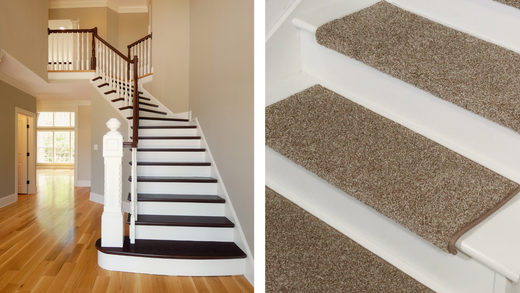When it comes to home safety, homeowners should pay special attention to the stairs. Stair-related accidents in homes are more common than one might think, and the safety of stair treads plays a significant role in preventing these accidents. There are several different types of stair treads to choose from. In this article, we will cover carpet stair treads and rubber stair treads.
So, are stair treads safe?
Yes, they can be extremely safe. But, there are a few factors that affect the amount of safety they provide, which include:
-
Quality of materials
-
Proper installation
-
and regular maintenance
Factors Affecting the Safety of Stair Treads
The safety of stair treads is influenced by several key factors, including the quality of materials used, proper installation techniques, and regular maintenance and upkeep.
The quality of materials used in stair treads directly impacts their safety. Stair treads made from high-quality materials, such as aluminum oxide abrasive grit, provide better traction and slip resistance, reducing the risk of accidents.
Proper installation techniques are also crucial for ensuring the safety of stair treads. Securely fastening the treads to the stairs and ensuring that they are level and free from any defects is essential for preventing slips and falls.
Regular maintenance and upkeep of stair treads are necessary to retain their safety features. Over time, wear and tear can diminish the effectiveness of anti-slip treads, making it important to inspect and maintain them regularly.
Carpet Stair Treads
Are carpet stair treads safe? Yes, carpet stair treads offer several benefits that make them an excellent choice for moms looking to enhance the safety of their homes.
Benefits of Carpet Stair Treads
Enhanced traction and slip resistance are among the primary benefits of carpet stair treads. The added friction provided by the carpet surface reduces the risk of slipping, especially for young children and pets who may be more prone to accidents on stairs.
Noise reduction in the home is another advantage of carpet stair treads. The soft surface of the carpet absorbs sound, making the stairs quieter and more peaceful, which is especially beneficial in busy households.
Additionally, carpet stair treads provide added comfort and warmth for children and pets. The softness of the carpet makes the stairs more inviting and cozy, encouraging children and pets to use them safely.
Rubber Stair Treads
Rubber stair treads are another excellent option for moms looking to prioritize safety in their homes.
Benefits of Rubber Stair Treads
Exceptional durability and longevity are key benefits of rubber stair treads. They can withstand heavy foot traffic and are resistant to wear and tear, making them a long-lasting safety solution for stairs.
Rubber stair treads are also easy to clean and maintain, requiring minimal effort to keep them in top condition. This is particularly advantageous for busy moms who need low-maintenance safety solutions in their homes.
Resistance to moisture and mold is another advantage of rubber stair treads. In areas prone to humidity or spills, rubber treads provide a reliable non-slip surface that is resistant to moisture and mold growth.
Proper Installation Techniques:
-
Measure the dimensions of each stair step, in order to purchase the correct size stair treads.
-
Clean the stairs thoroughly before applying stair treads to ensure a smooth and clean surface for the treads to adhere to.
-
Apply a doublesided carpet tape or adhesive to the back of the carpet stair tread, following the manufacturer's instructions for proper application. Or simply remove protective backing off built-in adhesive stair treads.
-
Press the carpet stair tread firmly onto the step, starting from the front and smoothing out any wrinkles or air bubbles as you go.
Conclusion
In conclusion, the safety of stair treads is a crucial consideration for those looking to create a secure home environment for their families. By prioritizing the quality, installation, and maintenance of stair treads, you can significantly reduce the risk of stair-related accidents.



